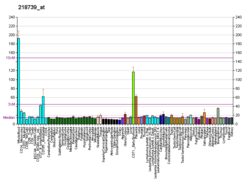ABHD5

1-acylglycerol-3-phosphate O-acyltransferase ABHD5, also known as comparative gene identification-58 (CGI-58),[5] is an enzyme that in humans is encoded by the ABHD5 gene.[6][7]
Function
[edit]The protein encoded by this gene belongs to a large family of proteins defined by an alpha/beta hydrolase fold, and contains three sequence motifs that correspond to a catalytic triad found in the esterase/lipase/thioesterase subfamily. It differs from other members of this subfamily in that its putative catalytic triad contains an asparagine instead of the serine residue. Mutations in this gene have been associated with Chanarin-Dorfman syndrome, a triglyceride storage disease with impaired long-chain fatty acid oxidation.[7][8]
CGI-58 is known to be a co-activator of adipose triglyceride lipase (ATGL/PNPLA2) that associates with lipid droplets in association with perilipin proteins.[5] Phosphorylation of certain perilipins by protein kinase A causes dissociation of CGI-58 from the perilipins and permits interaction with ATGL.[5] CGI-58 additionally interacts with beclin 1,[5][9] and CGI-58 has been shown to promote autophagy in colorectal cancer in a PNPLA2-independent manner.[9][10]
References
[edit]- ^ a b c GRCh38: Ensembl release 89: ENSG00000011198 – Ensembl, May 2017
- ^ a b c GRCm38: Ensembl release 89: ENSMUSG00000032540 – Ensembl, May 2017
- ^ "Human PubMed Reference:". National Center for Biotechnology Information, U.S. National Library of Medicine.
- ^ "Mouse PubMed Reference:". National Center for Biotechnology Information, U.S. National Library of Medicine.
- ^ a b c d Yu L, Li Y, Grisé A, Wang H (2020). "CGI-58: Versatile Regulator of Intracellular Lipid Droplet Homeostasis". In Jiang XC (ed.). Lipid Transfer in Lipoprotein Metabolism and Cardiovascular Disease. Advances in Experimental Medicine and Biology. Vol. 1276. Singapore: Springer. pp. 197–222. doi:10.1007/978-981-15-6082-8_13. ISBN 978-981-15-6081-1. PMC 8063591. PMID 32705602.
- ^ Ghosh AK, Ramakrishnan G, Chandramohan C, Rajasekharan R (Sep 2008). "CGI-58, the causative gene for Chanarin-Dorfman syndrome, mediates acylation of lysophosphatidic acid". The Journal of Biological Chemistry. 283 (36): 24525–33. doi:10.1074/jbc.M801783200. PMC 3259832. PMID 18606822.
- ^ a b "Entrez Gene: ABHD5 abhydrolase domain containing 5".
- ^ Lefèvre C, Jobard F, Caux F, Bouadjar B, Karaduman A, Heilig R, Lakhdar H, Wollenberg A, Verret JL, Weissenbach J, Ozgüc M, Lathrop M, Prud'homme JF, Fischer J (Nov 2001). "Mutations in CGI-58, the gene encoding a new protein of the esterase/lipase/thioesterase subfamily, in Chanarin-Dorfman syndrome". American Journal of Human Genetics. 69 (5): 1002–12. doi:10.1086/324121. PMC 1274347. PMID 11590543.
- ^ a b Peng Y, Miao H, Wu S, Yang W, Zhang Y, Xie G, Xie X, Li J, Shi C, Ye L, Sun W, Wang L, Liang H, Ou J (2016). "ABHD5 interacts with BECN1 to regulate autophagy and tumorigenesis of colon cancer independent of PNPLA2". Autophagy. 12 (11): 2167–2182. doi:10.1080/15548627.2016.1217380. PMC 5103361. PMID 27559856.
- ^ Ou J, Peng Y, Yang W, Zhang Y, Hao J, Li F, Chen Y, Zhao Y, Xie X, Wu S, Zha L, Luo X, Xie G, Wang L, Sun W, Zhou Q, Li J, Liang H (2019). "ABHD5 blunts the sensitivity of colorectal cancer to fluorouracil via promoting autophagic uracil yield". Nature Communications. 10 (1): 1078. Bibcode:2019NatCo..10.1078O. doi:10.1038/s41467-019-08902-x. PMC 6403256. PMID 30842415. 1078.
External links
[edit]- Human ABHD5 genome location and ABHD5 gene details page in the UCSC Genome Browser.
Further reading
[edit]- Andersson B, Wentland MA, Ricafrente JY, Liu W, Gibbs RA (Apr 1996). "A "double adaptor" method for improved shotgun library construction". Analytical Biochemistry. 236 (1): 107–13. doi:10.1006/abio.1996.0138. PMID 8619474.
- Yu W, Andersson B, Worley KC, Muzny DM, Ding Y, Liu W, Ricafrente JY, Wentland MA, Lennon G, Gibbs RA (Apr 1997). "Large-scale concatenation cDNA sequencing". Genome Research. 7 (4): 353–8. doi:10.1101/gr.7.4.353. PMC 139146. PMID 9110174.
- Lai CH, Chou CY, Ch'ang LY, Liu CS, Lin W (May 2000). "Identification of novel human genes evolutionarily conserved in Caenorhabditis elegans by comparative proteomics". Genome Research. 10 (5): 703–13. doi:10.1101/gr.10.5.703. PMC 310876. PMID 10810093.
- Schleinitz N, Fischer J, Sanchez A, Veit V, Harle JR, Pelissier JF (Jun 2005). "Two new mutations of the ABHD5 gene in a new adult case of Chanarin Dorfman syndrome: an uncommon lipid storage disease". Archives of Dermatology. 141 (6): 798–800. doi:10.1001/archderm.141.6.798. PMID 15967942.
- Lass A, Zimmermann R, Haemmerle G, Riederer M, Schoiswohl G, Schweiger M, Kienesberger P, Strauss JG, Gorkiewicz G, Zechner R (May 2006). "Adipose triglyceride lipase-mediated lipolysis of cellular fat stores is activated by CGI-58 and defective in Chanarin-Dorfman Syndrome". Cell Metabolism. 3 (5): 309–19. doi:10.1016/j.cmet.2006.03.005. PMID 16679289.
- Yamaguchi T, Omatsu N, Morimoto E, Nakashima H, Ueno K, Tanaka T, Satouchi K, Hirose F, Osumi T (May 2007). "CGI-58 facilitates lipolysis on lipid droplets but is not involved in the vesiculation of lipid droplets caused by hormonal stimulation". Journal of Lipid Research. 48 (5): 1078–89. doi:10.1194/jlr.M600493-JLR200. PMID 17308334.
- Ben Selma Z, Yilmaz S, Schischmanoff PO, Blom A, Ozogul C, Laroche L, Caux F (Sep 2007). "A novel S115G mutation of CGI-58 in a Turkish patient with Dorfman-Chanarin syndrome". The Journal of Investigative Dermatology. 127 (9): 2273–6. doi:10.1038/sj.jid.5700860. PMID 17495960.
- Fischer J, Negre-Salvayre A, Salvayre R (2007). "[Neutral lipid storage diseases and ATGL (adipose triglyceride lipase) and CGI-58/ABHD5 (alpha-beta hydrolase domain-containing 5) deficiency: myopathy, ichthyosis, but no obesity]" (PDF). Médecine/Sciences. 23 (6–7): 575–8. doi:10.1051/medsci/20072367575. PMID 17631826.





